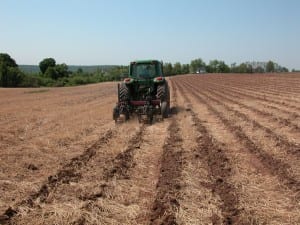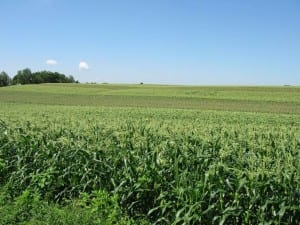Vegetable Farmers Switch to Reduced Tillage/Deep Zone Tillage
By Jude Boucher, UConn Extension Educator

In 2006, after several 4 to 6-inch rainstorms, and having to contend with 4-foot deep erosion gullies in his sweet corn fields, Nelson Cecarelli of Cecarelli Farm decided he needed a better way to farm the rolling hills of Northford and Wallingford. After speaking with several growers and an equipment dealer from upstate New York about a form of reduced tillage, known as deep zone tillage (DZT), he contacted UConn Extension Educator Jude Boucher, for advice and for help transitioning to this new type of field preparation system. Together they researched reduced-till options and practices, including different deep zone tillage machines.
The DZT machine allows a grower to just prepare a narrow seed bed, only inches wide, rather than exposing the surface of the whole field to wind and rain. It also allows farmers to till deeply, right under the crop row, with a 24-inch shank, to loosen any hardpan that has formed after years of using a plow and harrow. This allows the soil to absorb and retain more water and allows the plants to extend their roots deeper into the soil. The system also improves soil quality over time.
UConn Extension and Nelson co-wrote and participated in a pair of grants aimed at documenting the benefits and problems encountered while using DZT compared with conventional ways of field preparation. With the success of the new system, a second goal was convincing other growers to adopt DZT. Jude and Nelson also recruited a second farmer, Tom Scott of Scott’s Yankee Farmers in East Lyme, who bought a machine and joined them on their mission in 2008. UConn Extension helped conduct Soil Health Tests on most fields on the two farms to quantify compaction, organic matter content, and several other important physical, biological and chemical characteristics of a healthy soil so improvements could be monitored over time.
Nelson and Tom participated in the introductory conference on DZT conducted by UConn Extension in 2008 and a final grant-funded workshop in 2013, have hosted twilight meetings about DZT on their farms, and made about a dozen presentations over the years at various workshops and at state and regional grower conferences. They have also been featured in DZT case studies published in UConn Extension’s Crop Talk Newsletter and on the UConn IPM Web Site (www.ipm.uconn.edu/). They both served as mentor-growers for the grants and entertained questions and visits from other growers interested in adopting DZT.

As a result of his move to reduced tillage, Nelson evolved from a farmer just looking to solve an erosion problem on his farm, to one obsessed with improving soil quality. He started to find additional ways of reducing tillage and soil compaction, and improve and expand his use of cover crops. First, he planted summer cover or smother crops, such as buckwheat, after harvesting early sweet corn or other spring crops, so that he wouldn’t have to repeatedly harrow- down weeds to prevent them from going to seed in late summer. He bought a grain drill to both improve his cover crop stands due to precision planting, and to reduce additional passes with the harrow associated with tilling down crop residue and planting cover crop seed. He moved from using just winter rye, to using mixes of tillage radishes and rye or oats, and then to sun hemp and mixes or blends of multiple cover crops to protect the soil and add more organic matter. He also adopted the use of permanent driveways in some fields and switched from side-dressing corn, which involves cultivation, to banding all his nitrogen and phosphorus fertilizer at planting by placing it both under and on the sides of the seed row.
Tom was not bashful about trying DZT on all the crops on his farm: both annuals and perennials. He figured that if it made sense to loosen the compacted soil under his annual vegetable crops, then it made twice as much sense to loosen it when replanting apples or blueberries where you only get one chance in many years. He also immediately started to make adjustments to his DZT machine by reducing the spring tension so that the deep shank would trip easier in his rocky ground, and by adding hydraulic lifts on the wheels so he could roll it to fields across town, instead of lifting it with the tractor. He also designed and built a fifth-wheel style hitch for his planter so that he could prepare and seed the field all in one pass. Lately, with the aid of a USDA grant, he added a roller-crimper to the front of his tractor, to kill the winter cover crop (rye) without herbicides, and continue his pursuit of a single-pass farming system.
Tom also calculated exactly how much time and fuel it took to prepare one acre for planting using DZT versus a plow and harrow. He determined that DZT produced a 67% savings in time and a 72% savings in fuel. These savings increased even more when he started planting at the same time he prepared the seedbed. Nelson’s fuel deliveryman actually complained that the farm wasn’t using near as much fuel as it had in the past. Both growers have succeeded in dramatically reducing soil compaction and erosion on their farms, while improving crop yields and quality. Through their efforts, and UConn Extension’s, to help spread the word, there are now Extension programs in all six New England states advocating the use of DZT, and over 40 growers in the region have switched to DZT and a better way of farming.